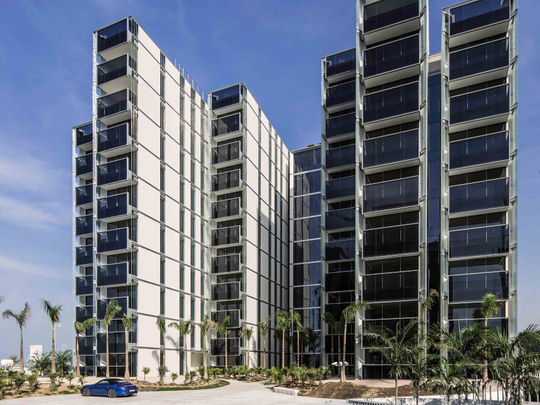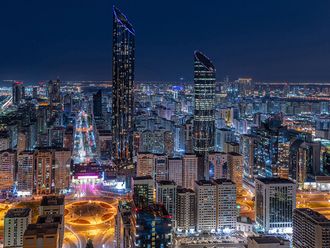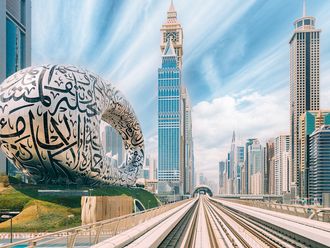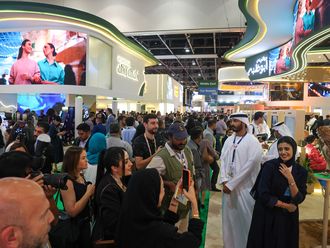
A reputation for delivering striking yet practical structures founded on the principles of local context and integration into the surrounding landscape preceded RCR Arquitectes’ debut in the region. With an eclectic portfolio of European projects, ranging from the Hofheide Crematorium in Belgium and Musée Soulages in Rodez, France, to the Tossols-Basil Athletics Track in the firm’s Catalonian home base of Olot, its trio of principals — Rafael Aranda, Carmen Pigem and Ramon Vilalta — were stepping into new territory with the Muraba Residences brief.
The decision to tackle something entirely new, both in terms of asset type (residential) and market (Middle East) brought with it some interesting challenges and opportunities.
Located on the Eastern Crescent of the Palm Jumeirah, the ultra-high-end residential project was also a first for Muraba Properties’ founder, Ibrahim Al Ghurair, whose brief was to design the luxury apartments “from the inside out”.
Aranda and the team weren’t fazed either by the unique environment or brief, as he explains: “Dubai architecture is often very challenging and, at the same time, is often missing an element of Arabian culture and taste, but the challenges we faced were the same as with every process in architecture.”
The opportunity to create a new style of living space in the city was clearly too great an opportunity to pass on, and the client was also confident of RCR’s abilities, even before the announcement of its 2017 Pritzker Architecture Prize accolade.
“The Pritzker Architecture Prize is often cited as the Nobel Prize of architecture and is recognition for the great work RCR has done,” says Al Ghurair. “We knew RCR was the right partner for us to develop the vision for Muraba Residences Palm Jumeirah, and this award cements that decision.”
Organic design
The creation of spaces and structures that have a natural affinity and organic relationship with their surroundings, while delivering memorable visual impact as well as a timeless quality, characterises RCR’s design philosophy.
Dubai was a different ball game entirely, according to Aranda, with its profusion of distinctly different architectural styles that have created a cityscape quite unlike any other major gateway city.
“The apartments we have created are designed with a certain sensibility in mind: a considered visual aesthetic, but also a conscious desire to create a positive ambience and a connection with the environment that may not be entirely tangible,” says Aranda.
The high-end, low-density Muraba Residences comprises just 46 apartments and four penthouses, each offering panoramic views of the Gulf waters and Dubai skyline. Putting living spaces first was essential, with Al Ghurair specifically requesting that rather than designing the apartments to fit the building, the architects should seek inspiration from the waterfront aspect and positioning to create residential spaces that would speak to prospective residents from an holistic lifestyle perspective.
The team at RCR also wanted to encourage openness in terms of the spatial feel, but without compromising privacy. Says Aranda, “We were inspired from the beginning to design something totally unique. The building is aligned not only with its physical location, with the rising and the setting of the sun, but also with a certain kind of mindset; one that would be appreciative of a more sophisticated architectural philosophy, as well as keen attention to detail.
“As a result, the spaces are carefully considered, not just in their proportion and relation to each other, but also to how the light behaves throughout the day — from East to West and dawn to dusk. As the brief dictated, designed ‘from the inside out’, with the resident in mind.”
Inspired by nature
In a city where luxury living often comes as standard from a developer standpoint, Aranda and the team wanted to ensure that the residences stood apart from other high-end residential developments, and that’s where the natural environment came into play.
“To look out across the horizon is always inspiring,” he says. “To watch the sun rise over the city — your city — this energises your thoughts and crystallises your intuition.
“We used the power of the sea to do this. All of the apartments face the sea and the fluidity of the space filters perceptions and also enriches the quality of the space. The quality of the materials both inside and out represents precision, homogeneity and engenders a contemporary feeling, as well as being timeless.”
The importance of creating living spaces that connect with the environment beyond the four walls was an important consideration, with RCR using glass filters and terraces to ensure that the ocean was visibly optimised wherever possible.
For Aranda, light was also a fundamental component in bringing the brief to life, and was integrated throughout the different spaces by watching how it behaves during the course of the day and its movement through each successive room.
Liveable reality
The smooth transition between outdoor and indoor spaces allows the natural environment to seamlessly cohabit within the building’s architecture, adding value to the residents’ “journey” through their home. As Aranda explains, “Living in an apartment it is necessary to consider the space in terms of the entirety of purpose. It is an atmosphere where you, as the resident, are involved in each and every space, together with the connecting areas.”
The four penthouses also draw on the same theme and mood, but across a substantially larger footprint, adding to the overall living experience.
RCR Arquitectes was also responsible for the design of the public spaces and residential amenities, such as the pool and gym. “We ensured that there was continuity throughout the building in terms of space configuration, atmosphere and use of materials etc,” says Aranda. “To be at home is to be entirely at ease with your surroundings. The space, the flow, it all needs to be entirely in tune. Ultimately, this is what we would like you to sense in our design.”
With its first residential project a liveable reality, RCR is now working on other projects in France but will be making a return to Dubai in the near future. “We are now working on a very interesting school project, which covers education from kindergarten through to university, within an educational campus,” says Aranda. “Site works will start next fall.”












